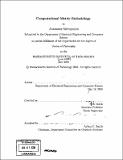Computational metric embeddings
Author(s)
Sidiropoulos, Anastasios
DownloadFull printable version (9.147Mb)
Other Contributors
Massachusetts Institute of Technology. Dept. of Electrical Engineering and Computer Science.
Advisor
Piotr Indyk.
Terms of use
Metadata
Show full item recordAbstract
We study the problem of computing a low-distortion embedding between two metric spaces. More precisely given an input metric space M we are interested in computing in polynomial time an embedding into a host space M' with minimum multiplicative distortion. This problem arises naturally in many applications, including geometric optimization, visualization, multi-dimensional scaling, network spanners, and the computation of phylogenetic trees. We focus on the case where the host space is either a euclidean space of constant dimension such as the line and the plane, or a graph metric of simple topological structure such as a tree. For Euclidean spaces, we present the following upper bounds. We give an approximation algorithm that, given a metric space that embeds into R1 with distortion c, computes an embedding with distortion c(1) [delta]3/4 (A denotes the ratio of the maximum over the minimum distance). For higher-dimensional spaces, we obtain an algorithm which, for any fixed d > 2, given an ultrametric that embeds into Rd with distortion c, computes an embedding with distortion co(1). We also present an algorithm achieving distortion c logo(1) [delta] for the same problem. We complement the above upper bounds by proving hardness of computing optimal, or near-optimal embeddings. When the input space is an ultrametric, we show that it is NP-hard to compute an optimal embedding into R2 under the ... norm. Moreover, we prove that for any fixed d > 2, it is NP-hard to approximate the minimum distortion embedding of an n-point metric space into Rd within a factor of Q(n1/(17d)). Finally, we consider the problem of embedding into tree metrics. We give a 0(1)approximation algorithm for the case where the input is the shortest-path metric of an unweighted graph. (cont.) For general metric spaces, we present an algorithm which, given an n-point metric that embeds into a tree with distortion c, computes an embedding with distortion (clog n)o ... . By composing this algorithm with an algorithm for embedding trees into R1, we obtain an improved algorithm for embedding general metric spaces into R1.
Description
Thesis (Ph. D.)--Massachusetts Institute of Technology, Dept. of Electrical Engineering and Computer Science, 2008. Includes bibliographical references (p. 141-145).
Date issued
2008Department
Massachusetts Institute of Technology. Department of Electrical Engineering and Computer SciencePublisher
Massachusetts Institute of Technology
Keywords
Electrical Engineering and Computer Science.